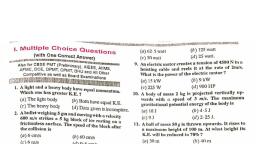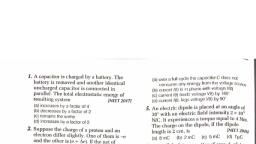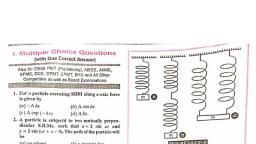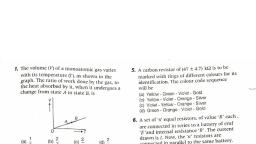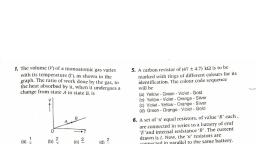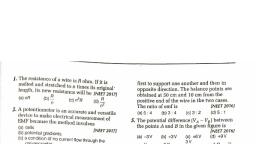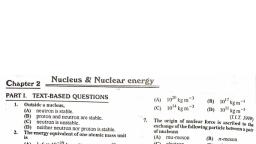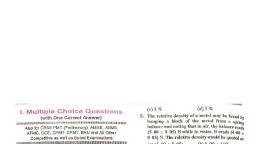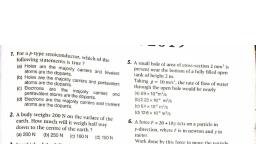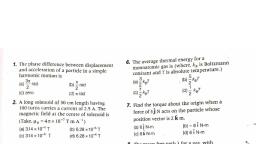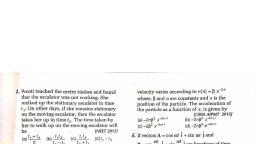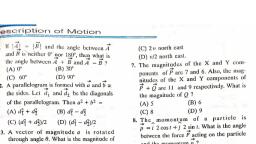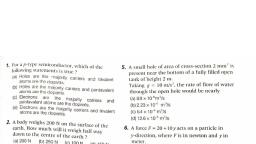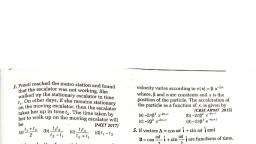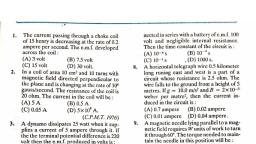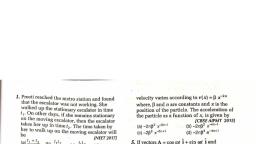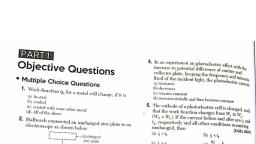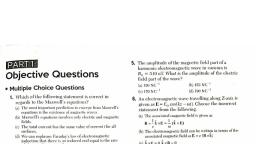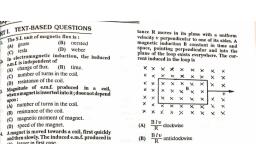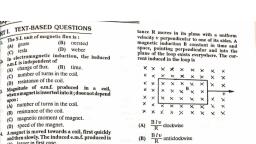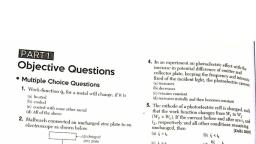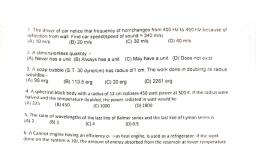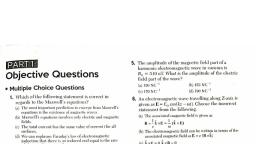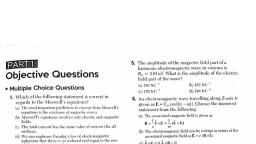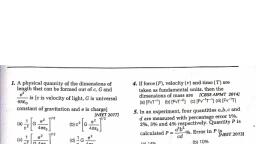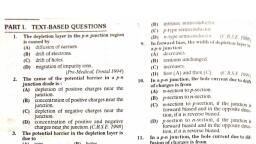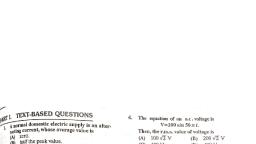Page 1 :
1. Two blocks A and B of massvs parallel and force constant is k’’, then 1, , , , riper F 7}, 3m and m respectively are ee Oe ei a, connected by a massless and 3m (a) 1:6 (by 1:9 (teat, eyes, inextensible string. The whole 5. A uniform circular disc of radius 50 cm at, system is suspended by a i" rest is free to turn about an axis which is, massless spring as shown in perpendicular to its plane and passes, figure. The magnitudes of acceleration of A through its centre, It is subjected to a, and B immediately after the string is cut, torque which produces a constant angular, are respectively INEET 2017) acceleration of 2.0 rad s~. Its net, , g 9 a9 scoleration in ms~ at the end of 2.0 5 isa, @g.Z (2, : dy 2,9 accele, 3 ) 3 * ag “ 33 approximately INEET 2016, , 2, One end of the string of length J is connected (a) 7.0 (b) 6.0 ese mo, toa particle of mass m and the other end is 6. Acar is negotiating a curved road of radius, connected to a small peg on a smooth R. The road is banked at angle 9. The, horizontal table. If the particle moves in circle coefficient of friction between the tyres of, with speed v, the net force on the particle the car and the road iswt,. The maximum, — —_— center) will be (T represents safe velocity on this road is INEET 2016], , tension in the string) (NEET 2017} Fag a, im? co fon H+ 180) [a (eases x ian |, (a)T wr + 1-1, tand \f 1-4, tano, Soe lo: et, mv? 9 { uw. + tand id) |gR? Hat ie |, (yr - 2 (d) Zero Oe 1p, tano : ne T= p,tano, , 3. Arope is wound around a hollow cylinder of 7. A particle moves so that its position vector, mass 3 kg and radius 40 cm. What is the is given by r = coswtx + sin wt y, where @, angular acceleration of the cylinder, if the is a constant. INEET 2016], , ‘ 30 N?, = — mes _ eae esate Which of the following is true?, 2 e he id ome? (a) Velocity and acceleration bath are parallel tor., (b) Velocity is perpendicular tor and acceleration, 4. A spring of force constant k is cut into 's directed towards to origin, lengths of ratio 1: 2: 3. They are (¢) Velocity is perpendicular to r and acceleration, . : is directed away form the origin, connected in series and the new force (d) Velocity and acceleration both are, constant is k’. If they are connected in perpendicular tor
Page 2 :
av, , 8. Aboy standing at the top of a tower of 20 m,, hvight drops a stone, Assuming, g © 10 mi",, the velocity with which it hits the ground Is, (a) 20 ms (CBSE AIPM 2011], (b) 40 nvs, (c) S5nvs, (d) 10 vs, , 9. A body is moving with velocity 30 m/s, towards East. After 10s, its velocity becomes, 40 mvs towards North, ‘The average, acceleration of the body is [CBSE AIPMT 2011], (a) 7s? (b) V7 mis* (c) Sm/s* (a) tmis?, , 10. A ball is dropped from a high rise platform, att =0 starting from rest. After 6 s, another, ball is thrown downwards from the same, platform with a speed v. The two balls, meet att = 18 s. What is the value of vu?, , (Take g = 10 ms™) [CBSE AIPMT 2010], (a)74ms"' (b) 55ms~' (c) 40ms~' (d) 6Oms™', , 11. A particle moves a distance x in time t, according to the equation x = (t + 5)~'. The, , acceleration of particle is proportional to, , [CBSE AIPMT 2010], (a) (velocity)*”* (b) (distance)*, (c) (distance)? (d) (velocity)*/?, , 12. A particle starts its motion from rest under, the action of a constant force. If the distance, covered in first 10 s is s, and that covered in, , the first 20siss,,then [CBSE AIPMT 2009], (a)s, =2s, (b) sp =35,, (c)s, =4s, (d) s, = 5,, , 13. A bus is moving with a speed of 10 ms™ on, a straight road. A scooterist wishes to, overtake the bus in 100 s. If the bus is at a, distance of 1 km from the scooterist, with, what speed should the scooterist chase the, , bus? ICBSE AIPMT 2009), (a) 20ms" (b) 40ms"', {c) 25ms™ (d) 10ms", , 14. A particle moves in a straight line with a, constant acceleration, It changes its, velocity from 10 ms“ to 20 ms“ while, passing through a distance 135 m int sec., The value oft is {CBSE AIPMT 2008}, {a) 10 (b) 1.8 (c) 12 (a9, , 15. A particle shows distance-time CURVE y, given In this figure. The maxtium, instantancous velocity of the particly j, , around the point (CBSE APU apy, o, Hk, 6, A (7, Time, (a) B (b)C {c)D (A, , 16. The distance travelled by a particle start;, from rest and moving with an acceleration, , 4 ins, in the third-second is, 3 (CBSE AIPMT 2008), (6m (b)4m_—(c) om (2m, 17. A particle moving along x-axis has, acceleration f, at time t, given by, , f=h (2 - r} where f, and T are, , constants. The particle at t = 0 has zero, velocity. In the time interval between ft =0, and the instant when f = 0, the particle's, velocity (v,) is (CBSE AIPMT 2007}, , (@4T —(b) ior (o) 47? (3 67, , 18. A car moves from X to Y with a uniform, speed v, and returns to X with a uniform, speed v,. The average speed for this round, trip is [CBSE AIPMT 2007}, , 2uy fou, YY a + &, Cc, id), (a) (0) Jae (Cc) ; (0), , 19. The position x of a particle w.r.t. time t, along x-axis is given by x = 90? - t?, where, x is in metre and ¢ in sec. What will be the, position of this particle when it achieves, maximum speed along the + x direction?, {CBSE AIPMY 2007], (a) 32m (b) 54m_— (ch B1 mM (d) 24m, 20. Two bodies A (of mass 1 kg) and B (of, mass 3 kg) are dropped from heights of 16 m, and 25 m, respectively, The ratio of the time, taken by them to reach the ground is, [CBSE AIPMT 2006], (c) 5/12 (d) 4/5, , (a)-5/4 (0) 12,5
Page 3 :
mea particle moves along a straight line OX., Ata time! (in second), the distance x {in, metre) of the particle from O is given by, x=40+121-¢3, , How long would the particle travel before, coming to rest? (CBSE ALPMT 2006], (a)24m = (b) 40m ()S6mM — (d) 16m, , 22. The displacement x of a particle varies, with time fas x = ae“ +be™, where a,b, a, and B are positive constants. The velocity, of the particle will (CBSE AIPMT 2005), (a) decrease with time, (b) ba independent of a and p, (c) drop to zero whena =f, (d) increase with time, , 25. Aman throws balls with the same speed, vertically upwards one after the other at an, interval of 2 s, What should be the speed of, the throw so that more than two balls are, in the sky at any time? (Take g = 9.8 m/s?), , {CBSE AIPMT 2003), {a) Any speed less than 19.6 m/s, (b} Only with speed 19.6 m/s, (c) More than 19.6 m/s, (d) At least 9.8 m/s, , 24. If a ball is thrown vertically upwards with, speed u, the distance covered during the last, t sec of its ascent is [CBSE AIPMT 2003), , (aut ~ 3 ot? (b) w+ gt)t (c)ut (a) 3 ot?, , 25. A stone is thrown vertically upwards,, When stone is at a height half of its, maximum height, its speed is 10 m/s, then, the maximum height attained by the stone, is(g =10 m/s’) {CBSE AIPMT 2001], (8m (0) 10m (c) 15m _— (d) 20m, , 26. A particle moves along a straight line such, that Its displacement at any time t is given, by s=3t°+7¢7 + 14¢ +5, The acceleration, , of the particle at { = 1 is (CBSE AIPMT 2000], (a) 18 m/s* (b) 32m/s? (c) 29en/s® (d) 24 mis?, , 27. A car moving with a speed of 40 km/h can, be stopped after 2 m by applying brakes. If, the same car is moving with a speed of 80, km/h, what is the minimum stopping, distance? [CBSE AIPMT 1996}, , (a) 8m (b) 2m (c)4m () 6m, , 28. If, © car at rest, accelerates uniformly to a, , _ Of 144km/h in 20s, it covers a, , ts den, of [CBSE AIPMT 1997], ; m (b) 1440 m, , ) 400 m (d) 20m, , 29, i, a Position x of a particle varies with, ime t, as x = at? — bt}, The acceleration of, , the particle will be zero at time! equals to, [CBSE AIPMT 1997], , b) 2, os, , a, (d) b, , (a) zero, 2a, (c) oy, 30. If a ball is thrown vertically upwards with a, , velocity of 40 m/s, then velocity of the ball, after 2s will be(g = 10 m/s*), , [CBSE AIPMT 1996], (a) 15 m/s {0} 20 mis, (c) 25 mis {d} 28 mis, , 31. Three different objects of masses m4,, and m, are allowed to fall from rest and, from the same point O along three different, frictionless paths. The speeds of the three, objects on reaching the ground will be in, , the ratio of [CBSE AIPMT 1995], (a) mm, «im, (0) m,:2m, 3m,, (o)1.4:4 Gott, , m Mm My, , 52. The water drops fall at regular intervals, from a tap 5 m above the ground. The third, drop is leaving the tap at an instant when, the first drop touches the ground. How far above the ground is the second drop at that, instant ? (Take g = 10 m/s*), , [CBSE AIPMT 1995), (a) 125m (b)2.50m (c)375m (d)5.00m, , 33. A body is thrown vertically upwards from, the ground. It reaches a maximum height, of 20 m in 5 s. After what time it will reach, the ground from its maximum height, position ? {CBSE AIPMT 1995), (aj25s (b)5s (c) 105 (co) 25s, , 34. A stone released with zero velocity from, the top of a tower, reaches the ground in4, s. The height of the tower is (g = 10 m/s"), (CBSE AIPMT 1995], , ()80m — (a) 160m, , (a) 20m = (b) 40m
Page 4 :
BS be the cdrewt af Agere, the bul will become, suddenly beight, if {ORSE AMT 1989), =, , Samen q, , is) contact = made o ovaken, DY cortact 's mane, , ic} DoMmact ¢ DroKan, , (6). None of the adove, , 356 In a region of uniform magnetic induction, , B= 10" T, a circular coil of radius 30 cm, and resistance x* ohm is rotated about an, ads which is perpendicular to the direction, of 8 and which forms a diameter of the coil., , WV the coil rotates at 200 rpm the an th, of the alternating current induced jn the Nile, , is (CBSE Aimyy, ia 4x? mA Pay, ib) 30m, , ie) GMA, , «a 200mA, , S?. Bnergy in a current carrying coil jg storag, , in the form of ICBSE AIPA 19yy, , (a) electric field, , (b) magnetic field, , {c) dielectric strength, (@) heat, , 58. Eddy currents are produced when, , {CBSE AIPMT 1999, , (a) a metal is kept in varying magnetic field, (b) a metal is kept in steady magnetic field, {c) a circular coil is piaced in a magnetic field, (@) current is passed through a circular coil
Page 5 :
39, A ray of light travelling in a, medium of refractive ae “fate an, surface separating the medium from air at, an angle of incidence of 45°, For which of, the following value of 1 the ray can °, undergo total internal reflection?, , (CBSE AIPMT 2010,, (a) = 133 (ei = 140 !, Pees (d) = 1.25, , 40. A \ens having focal length f and aperture, of diameter d forms an image of intensity /., , Aperture of diameter ¢ in central region of, , lens is covered by a black, , paper. Focal, length of lens and intensity of image now, will be respectively {CBSE AIPMT 2010}, , (a) f ano + (0) 2! ana!, 4, , 2, , J f !, id) — and —, @>5 2, , (c) f and —, 4, , 41. A boy is trying lo start a fire by focusing, sunlight on a piece of paper using an, equiconvex lens of focal length 10 cm. The, diameter of the sun is 1.39 10° m and its, mean distance from the earth is, 4.5x 10!’ m, What is the diameter of the, sun's image on the paper ? [CBSE AIPMT 2008}, (a) 9.2 10 m (bo) 6.5x 10% m, (c)6.5x 10° m (0) 12.4 10% m, , 42. Two thin lenses of focal lengths f, and f,, , are in contact and coaxial. The power of, the combination is {CBSE AIPMT 2008], , (a) : w fe, 1, hth gy ite, ) 2 " fe, in a material, , 43. The frequency of a light wave, is2x 10" Hz and wavelength is 5000 A., , ‘The refractive index of material will be, , {CBSE AIPMT 2007], (a) 1.40 (b) 1.50, (c) 3.00 (g) 1.33, , on the bottom of a, , uid. A ray of light, ypto the surface of, , n is resting, , , , , , , the liquid and moves along its surface, , (see figure)., +—3 cm—>, , , , , , Coin, How fast is the light travelling in the liquid?, {CBSE AIPMT 2007], (a) 1.8x 10° mis {b)2.4x 10° mis, (c) 3.0x 10° mis (d) 1.2% 10 mis, , 45. A convex lens and a concave lens, each, having same focal length of 25 cm, are pul, in contact to form a combination of lenses., The power in diopters of the combination, is (CBSE AIPMT 2006}, , (a) 25 (b) 50 {c) infinite {dj zero, , 46. A microscope is focussed on a mark ona, piece of paper and then a slab of glass of, thickness 3 cm and refractive index 1.5 is, placed over the mark. How should the, microscope be moved to get the mark in, , focus again ? {CBSE AIPMT 2006], {a) 1 cm upward {b) 4.5 cm downward, {c) 1 cm downward (d) 2 cm upward, , 47. The angular resolution of a 10 cm diameter, telescope at a wavelength of 5000 A is of, , the order of [CBSE AIPMT 2005], {a) 10° rad (b} 10°? rad, {c) 10°* rad {d) 10-® rad, , 48. A telescope has an objective lens of 10cm, diameter and is situated at a distance of, one kilometre from two objects. The, minimum distance between these two, objects, which can be resolved by the, telescope, when the mean wavelength of, , light is 5000 A, is of the order of, [CBSE AIPMT 2004], , {a)0.5m = (b)5m (c)5mm_— (dj Sem, , 49. The refractive index of the material of a, prism is V2 and its refracting angle is 30°., One of the refracting surfaces of the prism, is made a mirror inwards. A beam of
